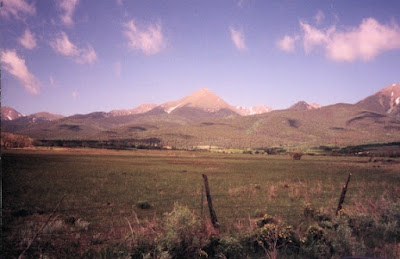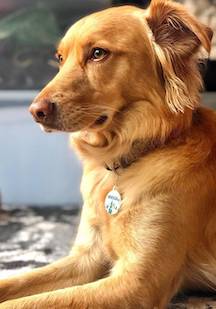"Fisher" was the name he came with. It was a little suburban for my taste, but, I thought, he has so much to learn, so why add learning a new name all that?
Wrong decision! I should have taken him to two or three dog-shamans for soul-retrieval and psychic cleansing, given him a dose of ayahuasca, changed his name, and dyed him blue. Anything for a fresh start.
It started when Jack's cancer was worsening and we knew that his days were limited. M. and I were sitting in Eske's Brew Pub in Taos that spring (Jack being back home at a wonderful boarding kennel) and decided that we should be thinking about another dog.
I contacted the breeder who had sold us Jack, but in the intervening dozen years she had dropped out of making new Chesapeake Bay retrievers.
Willing to adopt an adult dog, I contacted the Chesapeake Bay Retriever Relief and Rescue group. (As usual, most of the adoptable dogs were on the West Coast or the Upper Midwest or East Coast.) A volunteer from the Colorado Springs area came out down to meet us, meet Jack, and check out our home. She promised to be in touch.
 |
Fisher's first day — looking good — on land.
|
And she was! Someone in Denver had brought her a 2-year-old dog. He was not yet listed on the website. Would we like to meet him?
We took two vehicles so that Shelby could come and meet him at a neutral site. When we arrived, there he was, sitting a perfect Sit on her kitchen floor while she tossed him cheese bits.
"He's a food whore," she said. Truer words never spoken.
The two dogs met, sniffed — no conflict.
The previous owner was there. He said something about a divorce, no one home all day . . . kids . . . whatever. And he said that when Fisher swam in a lake, "they had a hard time getting him out." That should have been a warning.
Not only was he a food whore, he was a food bully. When I tried feeding both dogs in opposite corners of the kitchen, he inhaled his kibble, ran over to Shelby, body-slammed her out of the way, and inhaled her food too. So, separate rooms.
(Jack, meanwhile, gave Fisher a menacing growl, and immediately started sinking fast, to where he had to be put down the next day. I wished that he had not had to see the new dog arrive.)
The next day, I took him down to the dog swimming hole (picture here). I tossed in one of the retrieving dummies, and he sprang after it — and kept going. Barking crazily, he rampaged over the dam and headed downstream, splashing, wading, swimming.
I jogged down the parallel road, tracking his barks. When they stopped moving, I cut through someone's lawn and down to the creek, where he was standing calmly in a pool. I waded out and snapped a leash on him, then walked home in soggy jeans. What was that all about?
Another day, I tried a shallow pond. At first he dog-paddled normally, then it started — splashing with his front paws, biting the water, ignoring all commands. Thinking he was in distress, I stripped to my underwear and swam after him, herding him to the bank. In fact, he was not in distress at all. Given time, 10–15 minutes, he would stop and swim out
It's called "water-freaking," I learned in online forums. And no one seemed to have a cure for it, really. It appeared to be genetic. Watch this video and add more barking and more thrashing.
I tried working with him, using food mainly, to encourage him to be in the water without going nuts, but with only small success. It was like trying to cure epilepsy with dog biscuits.
In the long run, it meant he was only an upland hunting dog. With sharptail grouse or pheasants, he could be useful. But I had a Chesapeake who had to be kept away from water deep enough to swim in.
That was not the worse thing that he did
A year went by. He had some hunting experience, and we felt we were calming down his food aggression.
Then one summer day, when M. was setting out our meal on the front porch dining table, I heard her screaming. I ran out to find her backed up against the porch gate, her forearms bleeding, Fisher in fighting stance in front of her.
I grabbed the nearest object, a large metal dustpan, and lit into him like an angry ape, yelling and bashing him with the dustpan until I had chased him to the far end of the porch.
Then she and I spent some time disinfecting and bandaging her wounds. (That NOLS Wilderness First Aid class was helpful.)
 |
Fisher at 11. He never went gray.
|
I had a plan for him. I would put a pistol in my pocket, snap on his leash, take him for a walk up on the national forest, and come back alone. He had crossed a line and kept going. There would be no more.
So how he live to be almost 14? He could thank my wife's tender heart and a dog-writer in St. Louis.
When I told her my plan, she begged me not to do it. So I did not. But I had no Plan B.
She offered one. Her sister-in-law, a true dog-lover, lives in greater St. Louis and supports a group called Stray Rescue of St. Louis. The dogs they foster and try to re-home come with every behavioral and socialization problem that you can imagine. The group's founder, Randy Grim, put his experience into a book: Don't Dump the Dog: Outrageous Stories and Simple Solutions to Your Worst Dog Behavior Problems.
We did everything in Chapter 9, "Bullies with an Attitude." When other people came to the house, we either crated him, or we coached them on how to act. (Hint: He could be bribed.)
Things were better — until the day a neighbor stopped by, drove up to the house, and got out of his truck. I started down the steps to the driveway — and then Fisher, who had been napping on the porch, shot by me and launched himself at the guy. More defensive wounds. More bandaging and apologies — we ended up taking the neighbor and his wife to dinner at the best restaurant in the county.
But before that, they had gone to a walk-in urgent-care clinic for proper medicine, antibiotics, etc., and the clinic reported the dogbite to our county sheriff. I got a call from one of the public health nurses: "Just so you know, your dog was reported, and you will be hearing from the sheriff's office."
Yikes, his rabies vaccination was expired! I rushed him to the vet, so that when the bored deputy called, I could say, "Oh yes, he's up to date."
The law here is "Two Strikes and You're Out," but M. does not believe in dealing with The System, so he skated.
We tried one more thing that Randy Grim's book does not mention: bear spray. We live with bears, and in the summer, a canister sits on the kitchen counter, ready for walks in the woods or, heaven forbid, a home invasion via the back door.
The next time Fisher started acting aggressive toward her in the kitchen, M. gave him a shot of Udap cologne. It cooled his jets right away. "Ow! She bites back!" Once or twice more she just had to lift it up off the counter. He had learned.
All the aggression made it hard to get into his head, but eventually I figured out that inside the big dog was a scared dog. I don't think he had been mistreated, but he was missing something. One neighbor (whom Fisher never bit) used to just shrug his shoulders and say, "That dog was made on Monday." (Think of a GM auto plant in the 1970s.)
 |
Fisher hiking in the Wet Mountai
|
Sometimes we wondered if there was such a thing as canine autism, because when riding in a car he seemed overwhelmed by The World Out There. Must bark! Must jump around! Yet in a crate he would travel quietly all day long.


















